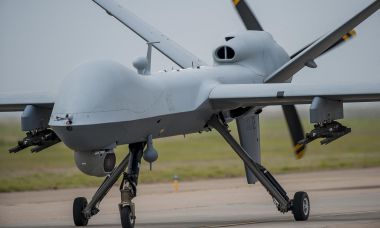The Russian Ministry of Defense Deploys Fighter Jets to Prevent Border Violations in the Black Sea
Introduction
In a recent development, the Russian Ministry of Defense has announced the deployment of Su-30 fighter jets in order to prevent border violations by US unmanned aircraft in the Black Sea. This move comes as tensions continue to escalate between the two nations in the region.
Unidentified Flying Object Detected
According to the Russian airspace control agency, on August 5th, they detected an unidentified flying object approaching from the Black Sea. This prompted the deployment of Su-30 fighter jets to identify and assess the situation.
Target Identified as US UAV
Upon closer inspection, the crew on the Su-30 fighter jets determined that the target in the air was a US unmanned aerial vehicle (UAV) known as the MQ-9A Reaper. The Russian Ministry of Defense confirmed this finding.
Escalation and De-escalation
As the Russian fighter jets approached, the MQ-9A Reaper swiftly changed its course and turned away from the border. This action was seen as an attempt to de-escalate the situation and avoid any potential conflict.
Successful Border Defense
After successfully completing their mission, the Su-30 fighter jets safely returned to their base. The Russian Ministry of Defense hailed this operation as a success in preventing any border violations by the US UAV.
Adherence to International Regulations
The Russian Ministry of Defense highlighted that throughout the entire operation, the mission strictly adhered to international regulations governing airspace use. Additionally, all proper aviation safety procedures were meticulously followed to ensure a safe and controlled operation.
US Response
As of now, the United States has not commented on or responded to the Russian Ministry of Defense’s deployment of fighter jets to intercept their UAV in the Black Sea. It remains to be seen how this incident will affect the already tense relationship between the two countries in the region.
MQ-9 Reaper: Capabilities and Specifications
Introduction
The MQ-9 Reaper, the UAV involved in the recent encounter with Russian fighter jets, is a highly sophisticated unmanned aerial vehicle with versatile capabilities for both reconnaissance and strike missions. This section will provide in-depth information about its specifications and features.
Design and Size
The MQ-9 Reaper boasts a substantial wingspan of approximately 20 meters, making it a sizable aircraft in the unmanned category. Its large size allows for extended flight endurance and payload capacity.
Weight and Maximum Load
With a maximum weight of 4.7 tons, the MQ-9 Reaper can carry a considerable payload, which includes various surveillance and reconnaissance equipment. This makes it an invaluable asset for intelligence gathering and monitoring activities.
Long Range Missions
Equipped with advanced technology, the MQ-9 Reaper has a remarkable range and endurance. It has the capability to operate for up to 27 hours continuously, covering distances of approximately 2,000 kilometers during each mission.
Reconnaissance and Weapon Systems
The primary purpose of the MQ-9 Reaper is not only surveillance and reconnaissance but also the potential for strike capabilities. It can be armed with guided missiles, such as the Hellfire, enabling it to engage targets with precision.
Past Incidents and Escalations in the Region
Collision Between US MQ-9 Reaper and Russian Fighter Jet
In a previous incident, a US MQ-9 Reaper collided with a Russian fighter jet over the Black Sea, resulting in the UAV falling into the water. The US military alleged that two Russian Su-27 fighters approached the MQ-9, flew dangerously close, and intentionally released fuel onto the unmanned aircraft. The collision caused damage to the UAV’s propeller, causing it to crash into the sea.
Russian Rebuttal of Collision Claims
However, the Russian Ministry of Defense denied these claims, asserting that the US MQ-9 Reaper changed its flight trajectory abruptly, experiencing a loss of altitude and subsequently losing control. They emphasized that the Russian fighter jets did not open fire, nor did they collide with the US UAV. The Russian jets safely returned to their base without incident.
Russian Intercepts of US Tactical Bombers
Additionally, the Russian military has reported intercepting US tactical bombers operating in the Baltic Sea on two separate occasions. These encounters highlight the escalating tensions between the two nations and their military activities in strategic regions.
Encounters with Other Nations’ Military Aircraft
The Russian Air Force has also had encounters with military aircraft from various other nations, including France, Germany, Poland, and the UK, in strategically important areas of the sea. While these encounters were not confrontational, they further exemplify the complex geopolitical dynamics in the region.
Conclusion
The deployment of Su-30 fighter jets by the Russian Ministry of Defense to prevent border violations by US UAVs in the Black Sea underscores the heightened tensions in the region. As both nations continue to assert their respective interests, close encounters and standoffs between their military assets are becoming more frequent. The situation remains tense, with international observers closely monitoring developments for any potential escalation.


